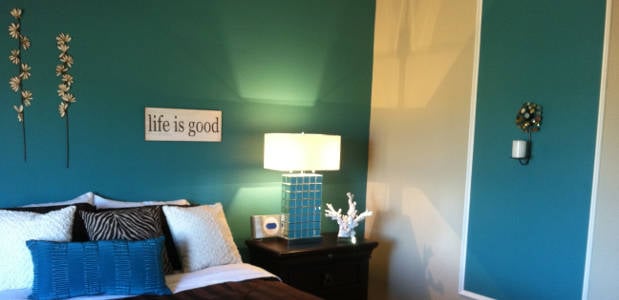
Most homes, whether new or pre-owned, are originally designed to attract potential homeowners, and the best way to draw people into a house is to make it look like they could possibly live there. To do this, home builders and realtors intentionally create a neutral look, which means light-colored carpets, wood cabinets, beige countertops, and most importantly, there’re going to be lots of white walls. However, when you move into a new house, you want to make it feel fresh and comfortable, and there’s nothing more boring and lifeless than being surrounded by drab interior painting.
Get the White Out
As we’ve said before: never underestimate the power of a fresh coat. Though white walls can certainly open up a space, if every surface lacks color, it can also feel claustrophobic. They can be neutral and modern, but white walls also tend to look institutional and impersonal. Plus they’re hard to keep clean and they quickly reveal any imperfection. You always want your home to feel, well, homey. And the only way to do this is to give your walls a splash of life. And don’t fear brave color choices: bold statements often lead to pleasing results. Here are some tips to help you get started in your color quest.
Selection Stress
The toughest part of interior painting is the selection process. What color works best for which walls? What will each room cost? To ease the stress, always focus on one crucial design principle: Matching.
- Match Your Taste: Don’t worry about color coordination. It’s your house, so don’t listen to anybody’s opinions but your own. You’re the one who has to look at the walls everyday, so choose whatever is most appealing to you and you alone.
- Match Your Décor: If you don’t know what you want, look at rest of the house. Consider your furniture, decorations, and style and harmonize with other room colors. Think about borders or wall paper and how to make everything feel uniform.
- Match Your Mood: Each room comes with a different mood. A family room wants to be active, a kitchen wants to be airy, an office wants to be studious, and a bedroom wants to be cozy. Make sure you match the ambiance of each room’s function.
- Match the Size: Think of the room size and how interior painting will affect it. Darker colors are moodier and cramp an area, whereas lighter colors can open up a space, so be careful about color shades as you make your selection.
Ready to start your Painting Project?
Find ProsDaring Design
After most homeowners get their paint swatches, debate different shades, and make a final selection, people tend to have a very universal concept about interior house painting: cover the entire room in one color. But why not get more creative? Don’t be afraid of experimentation. Unique, custom paint jobs have become quite popular and can really make a room pop. Here are some creative options you may want to consider:
- Accent Walls: Accents have become a growing trend in interior home painting. In fact, you can actually compliment your other three walls by covering a fourth wall with a bolder, contrasting shade.
- Faux Finishes: Creatively texture your walls in order to create mood and depth.
- Murals: Turn your walls into actual artwork. Hire a professional artist to paint a picture in the nursery. Use stencils to create a new border in the kitchen. Or maybe rubber stamp a striking pattern across your bathroom wall.
- Unusual Surfaces: Why not paint your floors, ceiling, tile work, cabinets, or wood paneling? It may be interesting to turn these overlooked areas into unique focal points.
Professional Interior Painting
When it comes to custom paint jobs, it’s always a good idea to hire a professional. They are better trained to work on uncommon projects. In fact, when it comes to any interior home painting, professional painters are well-equipped with experience and know how to deal with taping, trim work, baseboards, and any other problematic dilemmas. But even if you hire a pro, there are still some things you can do to prepare for their arrival:
- Room Removal: Before you paint, always remove all furniture and wall fixtures, including towel bars and electrical outlet covers.
- Lay the Groundwork: Put down and secure a drop cloth to protect your floors. Also, fill in any holes and thoroughly clean the walls.
- Prime the Project: You may have to use primer to make the project go faster. If you’re going to apply a lighter color over pre-existing dark hues, bright shades, or oil-based paint, you’ll always need to prime your walls first.
 Creating a Kid’s Fantasy World With Themed Murals
Creating a Kid’s Fantasy World With Themed Murals  Lead Paint Common Sense
Lead Paint Common Sense  Painting Your Home Happy: How Color Choices Affect Your Mood
Painting Your Home Happy: How Color Choices Affect Your Mood  Exterior Painting Techniques
Exterior Painting Techniques  Choosing Exterior Paint Colors
Choosing Exterior Paint Colors 

Are You Familiar With This Topic? Share Your Experience.